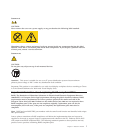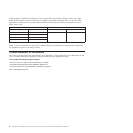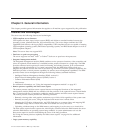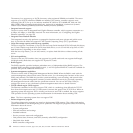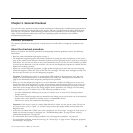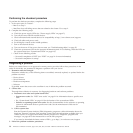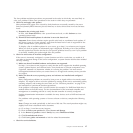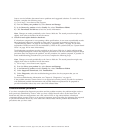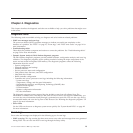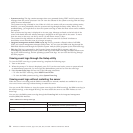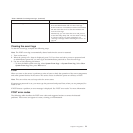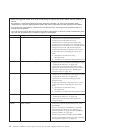
Chapter 3. General Checkout
You can solve many problems without outside assistance by following the troubleshooting procedures in
this Hardware Maintenance Manual and on the Lenovo Web site. This document describes the diagnostic
tests that you can perform, troubleshooting procedures, and explanations of error messages and error
codes. The documentation that comes with your operating system and software also contains
troubleshooting information.
Checkout procedure
The checkout procedure is the sequence of tasks that you should follow to diagnose a problem in the
server.
About the checkout procedure
Before you perform the checkout procedure for diagnosing hardware problems, review the following
information:
v Read the safety information that begins on page 1.
v The diagnostic programs provide the primary methods of testing the major components of the server,
such as the system board, Ethernet controller, keyboard, mouse (pointing device), serial ports, and hard
disk drives. You can also use them to test some external devices. If you are not sure whether a problem
is caused by the hardware or by the software, you can use the diagnostic programs to confirm that the
hardware is working correctly.
v When you run the diagnostic programs, a single problem might cause more than one error message.
When this happens, correct the cause of the first error message. The other error messages usually will
not occur the next time you run the diagnostic programs.
Exception: If multiple error codes or system-board LEDs indicate a microprocessor error, the error
might be in the microprocessor or in the microprocessor socket. See “Microprocessor problems” on
page 58 for information about diagnosing microprocessor problems.
v Before you run the diagnostic programs, you must determine whether the failing server is part of a
shared hard disk drive cluster (two or more servers sharing external storage devices). If it is part of a
cluster, you can run all diagnostic programs except the ones that test the storage unit (that is, a hard
disk drive in the storage unit) or the storage adapter that is attached to the storage unit. The failing
server might be part of a cluster if any of the following conditions is true:
– You have identified the failing server as part of a cluster (two or more servers sharing external
storage devices).
– One or more external storage units are attached to the failing server and at least one of the attached
storage units is also attached to another server or unidentifiable device.
– One or more servers are located near the failing server.
Important: If the server is part of a shared hard disk drive cluster, run one test at a time. Do not run
any suite of tests, such as “quick” or “normal” tests, because this might enable the hard disk drive
diagnostic tests.
v If the server is halted and a POST error code is displayed, see “Event logs” on page 19. If the server is
halted and no error message is displayed, see “Troubleshooting tables” on page 50 and “Solving
undetermined problems” on page 103.
v For information about power-supply problems, see “Solving power problems” on page 102.
v For intermittent problems, check the error log; see “Event logs” on page 19 and “Diagnostic programs
and messages” on page 68.
© Lenovo 2009. Portions © IBM Corp. 2007, 2009. 15



